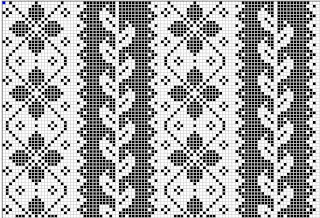Tue 28 Oct 2008
Every quarter has its week. The one where everything is just crazy and there’s no way around a whole lot of extra hours and stress. The “crunch” week.
Last week was the crunch week, and some of it is spilling over into this week as well. I’ve been working many nights, and am just too tired to feel like doing anything on the other nights. So, not much knitting to show.
Fortunately, I did manage to finish the mitts in time for the farmers’ market, where they were very well received. It turns out that the city is now charging $350 for a permit if farmers want to bring their space heaters, so a little extra warmth was much appreciated.
Finishing that project, of course, left me casting about for something else to work on. Aside from re-starting a sock that’s been languishing for months, I haven’t really done anything this week. But I’ve been thinking.
I’ve actually been thinking for some time now, but I didn’t want to talk about it too soon. Remember this yarn?
No? Well, that’s probably because I bought it this spring and never got around to doing anything with it. It’s been calling. It has even begun to creep.
This yarn is destined for a sweater, but it’s taken me a long time to decide on a pattern. I wanted a colorwork pattern, but I didn’t want strong horizontal stripes. Traditional fairisle wasn’t quite what I had in mind, and I really like the colorwork motif in the damask Kauni sweaters. I didn’t come up with an overall tiling that would work with solid colors as well as the Kauni does with the damask, but I’m thinking a good vertical pattern will balance out the color changes nicely.
 Inverting the foreground and background colors between the flower and vines stripes makes the vertical pattern really stand out, and I think it does nice things for the value balance. Inverting the whole pattern is also interesting:
Inverting the foreground and background colors between the flower and vines stripes makes the vertical pattern really stand out, and I think it does nice things for the value balance. Inverting the whole pattern is also interesting:

It’s kind of hard to tell which you like better in black and white, so I played around a bit with colors, too. I offset the color changes for the foreground and background by half a repeat to keep the change more subtle than it would be if I changed both at the same time.

And again, inverting foreground and background makes all the difference.

Having the light colors constant across a flower is nice because they don’t look chopped in half (Compare with last image).
 I think this is my favorite. Most of the weight is in the flower pattern, which is good because it establishes the color change rhythm. I also like the first pattern. I’ll probably have to do some swatching to really know which I like best.
I think this is my favorite. Most of the weight is in the flower pattern, which is good because it establishes the color change rhythm. I also like the first pattern. I’ll probably have to do some swatching to really know which I like best.
Now, I’m sure you’re wondering how I did this graphing. You see, I have a husband that programs computers as a hobby. He is always asking if he can program something for me. (I don’t understand this tendency, but I can definitely see the benefits of it!) He’s been working on this little project for a while now, and we are getting close to working charting software.
I wanted to wait until Branden had had a chance to test the hard parts of the code before saying anything, because I didn’t want him to have the pressure of a bunch of excited knitters before it was working. Coding is a long process with lots of stops and starts, and it’s nice to be over the big stops before having people (besides your wife…) turning blue from holding their breath about it being done. It’s getting close, but it’s not quite there yet. (Please, keep breathing!)
Apparently the fairisle was pretty easy to implement, but getting lace charts (!!) working has been a lot harder, and has broken a lot of the code for the fairisle. We’ve been doing a lot of debugging (i.e. he sends me the file, I break it, he fixes it), and it seems like this will turn into a pretty usable program. We still have a lot of kinks to iron out, especially in terms of speed, but it is coming, and it’s a pretty neat little program. If we can turn it into something that the average person could put up with using (harder than you’d think with computers…they have all kinds of idiosyncrasies that crop up in the most annoying ways), he will release it for general use. Yay for computer geeks!

